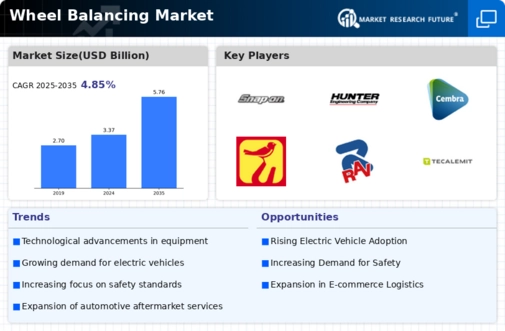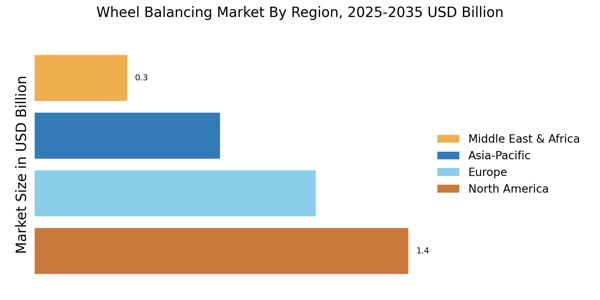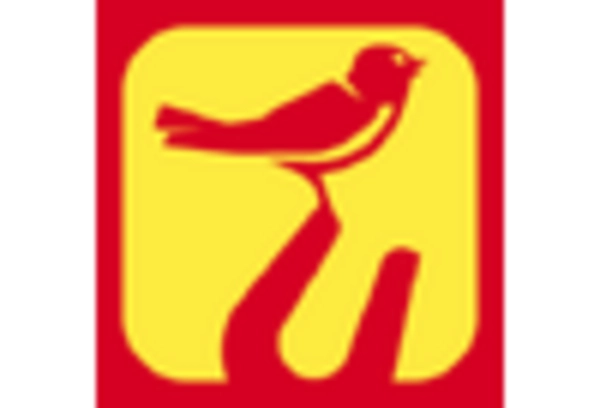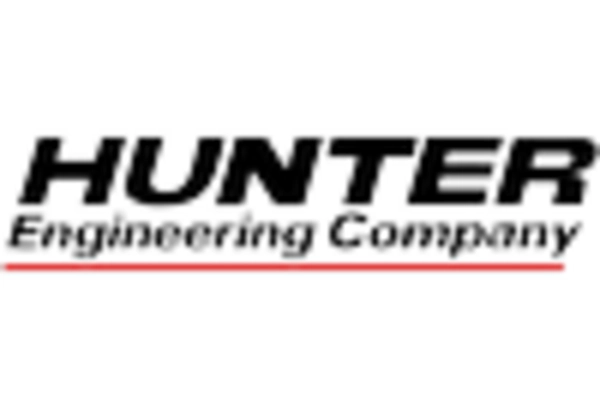Rising Vehicle Ownership
The increasing rate of vehicle ownership is a primary driver for the Wheel Balancing Market. As more individuals acquire vehicles, the demand for maintenance services, including wheel balancing, escalates. In recent years, vehicle ownership has surged, with statistics indicating that the number of registered vehicles has reached unprecedented levels. This trend is particularly evident in emerging markets, where economic growth has led to a burgeoning middle class. Consequently, the Wheel Balancing Market is likely to experience substantial growth as vehicle owners seek to enhance performance and safety through regular maintenance. Furthermore, the rise in vehicle ownership correlates with a heightened awareness of the importance of vehicle upkeep, thereby reinforcing the demand for wheel balancing services.
Growing Awareness of Vehicle Safety
The heightened awareness of vehicle safety among consumers is a crucial driver for the Wheel Balancing Market. As individuals become more informed about the implications of improper wheel balancing, they are more likely to seek professional services. Research indicates that unbalanced wheels can lead to uneven tire wear, reduced fuel efficiency, and compromised safety. This awareness has prompted consumers to prioritize regular maintenance, including wheel balancing, as a means to ensure optimal vehicle performance. Consequently, the Wheel Balancing Market is witnessing an uptick in demand as safety-conscious consumers actively seek out services that enhance their driving experience. This trend is likely to continue as educational campaigns and safety regulations further emphasize the importance of vehicle maintenance.
Expansion of Automotive Service Centers
The proliferation of automotive service centers is significantly contributing to the growth of the Wheel Balancing Market. As more service centers emerge, consumers gain easier access to wheel balancing services, which in turn drives demand. The expansion of these centers is often accompanied by the introduction of specialized services, including advanced wheel balancing techniques. Additionally, many service centers are adopting customer-centric approaches, offering promotions and packages that include wheel balancing as part of routine maintenance. This accessibility and convenience are likely to encourage more vehicle owners to prioritize wheel balancing, thereby bolstering the market. The competitive landscape among service providers may also lead to improved service quality and pricing strategies, further benefiting the Wheel Balancing Market.
Technological Innovations in Wheel Balancing
Technological advancements in wheel balancing equipment and techniques are significantly influencing the Wheel Balancing Market. Innovations such as computerized wheel balancers and dynamic balancing systems have improved the accuracy and efficiency of wheel balancing processes. These advancements not only enhance service quality but also reduce the time required for balancing, making it more appealing to consumers. The introduction of advanced diagnostic tools allows service providers to offer tailored solutions, thereby increasing customer satisfaction. As technology continues to evolve, the Wheel Balancing Market is expected to adapt, leading to enhanced service offerings and potentially higher market penetration. The integration of smart technologies may also pave the way for new business models within the industry.
Increase in E-commerce for Automotive Services
The rise of e-commerce platforms for automotive services is reshaping the Wheel Balancing Market. Consumers are increasingly turning to online platforms to book maintenance services, including wheel balancing, due to the convenience and transparency they offer. This shift towards digital solutions allows service providers to reach a broader audience and streamline their operations. E-commerce platforms often feature customer reviews and ratings, which can influence consumer choices and drive demand for reputable service providers. As more consumers embrace online booking, the Wheel Balancing Market is likely to see a transformation in how services are marketed and delivered. This trend may also encourage service providers to enhance their online presence and invest in digital marketing strategies to attract customers.


















Leave a Comment